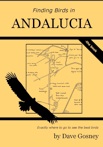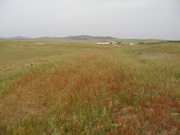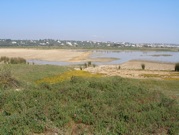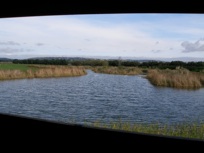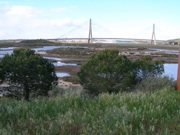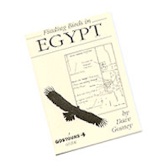Finding Birds in Egypt update
There is a new version of Finding Birds in Egypt which includes many new maps and several extra sites including Abassa fishponds, Hamata mangroves, Wadi Lahami, Shalatein, South of Safaga, Bir Beida and Sheik Shazly
St Catherine's monastery
There is a new map showing the location of this monastery and also Wadi Feiran in the updated version of Finding Birds in Egypt
Dec 1997 No Sinai Rosefinches but we did get Scrub Warbler, Desert Lark, Sand Partridge, Tristram's Grackles and Mourning Wheatears (Ray O'Reilly and Jane Passfield)
March 1999 Pair of Sinai Rosefinch in front of the Safary Camp hotel whose gardens are good for migrants (Helen Bantock)
July 2005 Early morning: a female Sinai Rosefinch c.200 yards south of the car park along the track to the monastery. The walled garden (or orchard) was pretty quiet apart from a couple of Scrub Warblers on the adjacent rocks. Also Rock Martin, White-crowned Black Wheatear and Desert Lark. A better site for Hume's Tawny Owl may be at Wadi Feiran, about 45 km west of Saint Catherine's. I had them there, a few km east of the Monastery of Seven Nuns (Richard Bonser, trip report on www.freewebs.com/richbonser)
Dec 2012 A Sunday visit is great because the monastery is closed so you have the place to yourself: Desert Lark, WCB Wheatear, 20 Tristram's Grackle, 5 Sinai Rosefinch (just beyond the monastery) (Colin Wilson)
Sharm el Sheik
In view of the changes to this area since my book was written, I've done a new map and added it to the 'extra maps' section but then updated it again in the recently updated version of the book.
December 1997 Cyprus warbler and Hooded wheatear in the strips of fertile land between the coast and the coast road (Ray O'Reilly and Jane Passfield)
April 1999 It is now possible to sail daily between Hurghada and Sharm el Sheik on a catamaran that takes only 2 hours (DG)
July 2005 Site 3 was completely dried up on my visit and offered no bird activity whatsoever - it is now merely an area of dry tamarisks that, on migration, are sure to pull in the odd bird or two. However, there is a new water treatment works north-west of Na'ama Bay. If you're heading from Sharm el Sheikh turn left (west) on the north side of Na'ama Bay at the Marriott (if you reach the Sonesta Hotel you've gone too far) and head along this track towards the desert. You'll come to a crossroads with the main Sharm-Dahab ring road and go straight over here and the treatment works are on the right after 600 metres [27.936N, 34.299E]. In a couple of visits I saw 7+ Lichtenstein's Sandgrouse (that came in at dusk onto the settlement lagoon closest to the road), 60+ Spotted Sandgrouse (from late afternoon until early evening on both visits) a Sooty Falcon, a pale morph Western Reef Egret, 3 Squacco Herons as well as waders including Spur-winged Plover, Marsh Sandpiper and Temminck's Stint. (Richard Bonser, trip report on www.freewebs.com/richbonser)
Dec 2012 Sonesta Club Hotel grounds (Naama bay): lots Bluethroats and Laughing Doves plus a regular Barn Owl, a Graceful Warbler and 2 Palestine Sunbirds Naama Bay sewage ponds: 30+ Water Pipits, Squacco, Long -legged Buzzard, Golden Eagle, Steppe Eagle, 4 Brown-necked Ravens and c100 Spotted Sandgrouse 'Old' sewage ponds: dry and useless apart from a Booted Eagle Movenpick Golf Course (explored by hiring a buggy for LE£20):Spur-winged Plover, GW Egret, Rock Martin, flamingoes, Short-toed Eagle Ras Mohammed: 2 G Sandplover, 1 Striated heron plus Slender-billed Gull, Caspian Tern, Pied Kingfisher, Osprey and, nearby, a Hooded Wheatear (Colin Wilson)
Hurghada
There is a new map of this site in the recently updated Finding Birds in Egypt
March 2006 2 Crested Terns were on posts at the Moussa Shrimps and Fish Farm, on the road north from Hurghada, just south of the 'Cairo 450' km sign. We also had a near-adult Great Black-headed Gull just offshore near the port; other gulls included 2 Caspian, 20 armenian, 2 Sooty and about 50 White-eyed. 20 km north of Hurghada is the El Gouna Golf Course which is good for migrants. We had 25+ Tawny Pipits, 120+ Short-toed Larks, 50+ Northern Wheatears, 20+ Hoopoes, c.15 Lesser Whitethroats, 20+ Black-headed Wagtails, c.20 Tree Pipits, a male Subalpine Warbler (of the race albistrata), a Chiffchaff, 4 Bluethroats, 2 Red-throated Pipits and a male Eastern Black-eared Wheatear (Richard Bonser, trip report on www.freewebs.com/richbonser)
24th June 2007 North of Hurghada, we found loads of birds in the bay next to the Panorama Bungalows resort (a couple of km north of the 'Cairo 450' km sign). These included 24 White-cheeked Terns, a White-winged Black Tern, 15 Lesser Crested Terns, 20 Caspian Terns and several White-eyed Gulls. (Richard Bonser, trip report on www.freewebs.com/richbonser)
Sept 2009 The image on Google Earth shows a sewage treatment works just north of the airport. I can only assume these will be good for waders and possibly sandgrouse. Coming from the airport, turn north on the road towards town but then left after 2.7 km on the 'ring-road'. Follow this for 6 km and you'll see the sewage works on the left after a roundabout. There are other (temporary?) pools to the right of the road too. In 1999, I visited a rubbish dump somewhere to the west of town and had at least 100 White-headed Gulls but it isn't obvious where it is on Google Earth - it could be the area immediately south-west of these pools, or it may have been tidied up since then. (DG)
Late Feb 2015 El Gouna golf course had lots Chiff-chaffs and Lesser Whitethroats but only 1-2 Bluethroat, Sardinian Warbler, Tawny Pipit, Black-headed Wagtail, Woodchat Shrike, Isabelline Wheatear, Red-throated Pipit. No larks or Hoopoes. Singing Nile Valley Sunbird at several sites around the El Gouna resort. South of golf course is a bay with limited growth of mangroves but this had Pied Kingfisher, Western Reef Heron, Greater Sandplover, Lesser Crested and Caspian Terns, Slender-billed Gulls and a few mixed waders. The lagoon just south of the Panaorama Bungalows resort (en route to Hurghada, not the one at El Gouna) had 13 Crested Terns, plus Caspian Terns, Slender-billed Gulls, Western Reef Heron, Spoonbill and a few waders. I was turned away from ‘Hurghada Water treatment works’ but glimpsed 2 ducks (Ferruginous?) flying over. Nearby plantations and reeds were practically birdless but ‘Mirafarm’ area north of the plantations is where hundreds of gulls now feed and rest, mostly White-eyed but also Armenian, Caspian and a 1st-winter Pallas’s Gull. No Sooty Gulls here but they were easy at Hurghada fish market next to the marina where I also had a Brown Booby flying over.
Suez
December 1997 Site 2 had 'hundreds' of Slender-billed and White-eyed Gulls, Lesser Crested and Sandwich Terns plus Great Black-headed Gulls, Black-necked Grebes and lots of waders (Ray O'Reilly and Jane Passfield)
April 1999 Site 1 is now a complete waste of time as the pools have been converted into boating lakes. Site 2 was rather disappointing - a few Lesser Crested Terns and Western Reef Herons were the highlights. Site 4 is also a waste of time as it has been 'tidied up'. (DG)
30th June 2007 Terns at site 2 included a couple of White-cheeked, c.15 Common, 5 Lesser Crested, 4 Whiskered and the only Sandwich Tern of the trip (Richard Bonser, trip report on www.freewebs.com/richbonser)
Ain Sukhna
April 1999. The Hotel at Ain Sukhna is now open to the public, although you still have to negotiate the guards at the entrance. I managed to get through without any problem but don't be surprised if a little 'baksheesh' is needed. It will be worth it because, by walking to the beach side of the hotel, you will be guaranteed superb views of gulls and terns on the jetty. These will usually include White-eyed Gulls and Crested Terns. Lesser Crested Terns are also regular and in April 1999 I had a Whiskered Tern which I failed to turn into a White-cheeked Tern. The road to site 3 was almost impassable from the south. It is best to approach from the north and return the same way. (DG)
March 2006 Site 2 (specifically, the El Sokhna resthouse) was best for raptor migration with 185 Lesser Spotted Eagles and 22 Steppe Eagles with hundreds of kites and Steppe Buzzards. Site 4 was relatively poor. (Richard Bonser, trip report on www.freewebs.com/richbonser)
Luxor
April 1999 At site 4, the water level was high and the reedbed much depleted but still yielded the regular species mentioned in the book plus Purple Heron, Night Heron and 2 Senegal Thick-knees. For the best light, visit in the evening and walk south from the hotel (DG)
24th March 2006 3 Red Avadavat at site 4, found by crossing the bridge onto the island, taking the track immediately to the left and continuing to a reedbed after a few hundred yards. We also had at least a dozen Nile Valley Sunbird plus Purple Swamphen, Striated Heron, Senegal Thick-knee, 3 Black-shouldered Kites and a Little Crake (Richard Bonser, trip report on www.freewebs.com/richbonser)
22nd April 2012 4 Greater Painted Snipe and 15+ Red Avadavat on Crocodile Island (Craig Fulcher).
May 2011 Kings (crocodile) Island has changed dramatically with the hotel doubled in size but still a great place to bird. the south and eastern edges of the island most interesting still. black winged kite still present favouring large trees to south. little green bee-eater favouring south western edge of island with senegal thick-knee, purple heron, yellow wagtail, crested lark. blue-cheeked and european bee-eaters displaying daily over eastern open fields close to bridge. good numbers of avadavat in reeds to south of bridge crossing with purple gallinule. night herons roosting in large avenue of trees from bridge to hotel, leaving each night at 6 to 6.30. plenty of nile valley sunbirds within hotel gardens themselves. hotel and tourism struggling following troubles and not sure what future holds for hugely expanded but three quarters empty Kings Island Hotel? (M J Roe)
Aswan
Feb 97 3 African Skimmers flew south down the Nile between Aswan and Luxor one evening.
Dec 97 Ferruginous Duck and Great White Egret also at Site 2
2009 An article by Bryan Bland (Birding World Vol 22, pages 289-299) points out that Three-banded Plover has bred at the 'fishponds below Tut Amon village, near the Aswan High Dam'. I can't find a village of the name on Google Earth; the only fishponds I can see are about 1 km down the west side of Lake Nasser from the western end of the High Dam. The same article points out a site for Namaqua Dove - at the camel market at Kom Ombo, 43 km north of Aswan (DG)
Abu Simbel
2007-2010. Sites for viewing the lake and also where Egyptian Nightjar and African Mourning Doves have been seen are shown in a new map in the updated edition of Finding Birds in Egypt just published
Cairo
Dec 1997 Lots of birds at site 7 including hundreds of Slender-billed Gulls, a flock of over 250 Kentish Plovers and a terrific range of other species including Great Black-headed Gull, Kittlitz's Plover, Marsh Sandpiper, Senegal Coucal and Senegal Thick-knee. (Ray O'Reilly and Jane Passfield)
Finding Birds in Egypt

